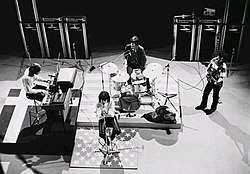Gothic rock
Gothic rock (also referred to as goth rock or simply goth) is a type of rock music. It came from post-punk in the late 1970s. The first gothic rock bands include Siouxsie and the Banshees,[3][4] Joy Division,[3][4][5] Bauhaus[3][4] and The Cure.[3][4]
| Gothic rock | |
|---|---|
| Stylistic origins | |
| Cultural origins | Late 1970s, United Kingdom |
| Typical instruments | |
| Derivative forms | ethereal wave |
| Subgenres | |
| Deathrock | |
| Fusion genres | |
| Other topics | |
Gothic rock sounds different from post-punk. It uses mostly minor chords and chords played on the bass guitar. It has sad lyrics that take inspiration from gothic fiction books. The lyrics sometimes talk about subjects like death and monsters. Gothic rock created a community that had its own nightclubs (places to dance and drink alcohol) and clothing style. This community is called the goth subculture.
Gothic Rock Media
The Doors performing live in 1968. They have been cited as a major influence in the gothic rock genre.
David Bowie influenced the post-punk bands that helped spawn the gothic rock genre
Gothic rock band Bauhaus performing live in August 2006
Robert Smith of the Cure in 1989, who was on the front cover of NME Originals: Goth in 2004.
The Sisters of Mercy performing at the M'era Luna Festival in 2005.
References
- ↑ "Darkwave". AllMusic.
- ↑ "Goth metal". Allmusic. Retrieved 2016-04-30.
- ↑ 3.0 3.1 3.2 3.3 Abebe, Nitsuh (24 January 2007). "Various Artists: A Life Less Lived: The Gothic Box". Pitchfork. Retrieved 10 March 2013.
- ↑ 4.0 4.1 4.2 4.3 "NME Originals: Goth". NME. 2004. Archived from the original on January 26, 2008. Retrieved 30 September 2013.
- ↑ Rambali, Paul (July 1983). "A Rare Glimpse into a Private World". The Face.
Curtis' death wrapped an already mysterious group in legend. From the press eulogies, you would think Curtis had gone to join Chatterton, Rimbaud and Morrison in the hallowed hall of premature harvests. To a group with several strong gothic characteristics was added a further piece of romance. The rock press had lost its great white hope, but they had lost a friend. It must have made bitter reading.





